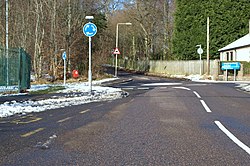Sunnyside Royal Hospital was a psychiatric hospital located in Hillside, north of Montrose, Scotland. It closed in 2011 and is now used for housing.[1]
| Sunnyside Royal Hospital | |
|---|---|
| NHS Tayside | |
 The south entrance to Sunnyside Royal Hospital (on the right) | |
| Geography | |
| Location | Hillside, Montrose, Angus, Scotland |
| Coordinates | 56°44′47″N 2°28′46″W / 56.74639°N 2.47944°W |
| Organisation | |
| Care system | NHS Scotland |
| Type | Specialist |
| Services | |
| Emergency department | No |
| Speciality | Mental health |
| History | |
| Opened | 1781 |
| Closed | 2011 |
| Links | |
| Lists | Hospitals in Scotland |
History edit
The hospital was founded in 1781 by Susan Carnegie as the Montrose Lunatic Asylum, Infirmary & Dispensary and obtained a Royal Charter in 1810. The original building was situated on the Montrose Links on a site bounded by Barrack Road, Ferry Road and Garrison Road.[2]
In 1834, the Governors of the asylum, carrying out the wishes of Mrs Carnegie (who had strongly advocated the appointment of a medical specialist in insanity) appointed the phrenologist William A. F. Browne as medical superintendent. Browne was to prove an inspired choice and an energetic and resourceful leader. He regarded public education as part of his duties, and gave a series of lectures which became enormously popular and influential. In 1837, five lectures were published together under the title What Asylums Were, Are and Ought To Be;[3][4] this book came to the attention of the Dumfries philanthropist Elizabeth Crichton. She travelled to Montrose, interviewed Browne and offered him the equivalent post at the Crichton Royal in Dumfries.[5] Browne was succeeded at Montrose by Richard Poole, an early psychiatric historian.[6]
Layout and design edit
In 1858, a new improved asylum designed by William Lambie Moffatt[7] was completed to the north of Montrose in the village of Hillside on lands of the farm of Sunnyside and the old site was vacated. This site was further developed with the construction of a new facility for private patients called Carnegie House in 1899. Despite this addition, overcrowding was a problem, as the asylum's patient numbers had grown to 670 by 1900. This situation required additional building work to be undertaken.
Consequently, two new buildings - Howden Villa (1901) and Northesk Villa (1904) - were added to the facility. Additional staff were required to care for the additional patients and the Westmount Cottages were built in 1905 to house them. In 1911 the lease of Sunnyside Farm finally expired and over 52 acres were purchased for the sum of £4,500. A further development was the addition of Angus House, which was built to accommodate elderly patients suffering from dementia in 1939.[2]
In 1948, the National Health Service 1946 (Scotland) Act brought the hospital under control of the Eastern Regional Hospital Board. Its name was changed from the Royal Asylum of Montrose to the Royal Mental Hospital of Montrose.[1]
Sunnyside Royal Hospital edit
In 1962 it became Sunnyside Royal Hospital and came under the jurisdiction of new management. During the 1950s and 1960s, the introduction of new drugs lessened the need for prolonged admission of patients. In addition, the Mental Health (Scotland) Act of 1960 also significantly altered legislation in respect of mental illness and reduced the grounds on which someone could be detained in a mental hospital.[8]
After the introduction of Care in the Community in the early 1980s, the hospital went into a period of decline and, once patients had been transferred to the Susan Carnegie Centre at Stracathro Hospital,[9] Sunnyside Royal Hospital closed in December 2011.[10]
The archives of the hospital are held by Archive Services, University of Dundee as part of the NHS Tayside archive.[11]
References edit
- ^ a b Gordon Holmes (19 May 2021). "Former mental hospital is centrepiece of new luxury housing development in splendid countryside location". The Scotsman. Archived from the original on 10 September 2021. Retrieved 16 October 2021.
- ^ a b "University of Dundee Archives Services Online Catalogue THB 23 Sunnyside Royal Hospital". University of Dundee. Archived from the original on 16 October 2021. Retrieved 21 August 2018.
- ^ Meagher, Sarah E; Millon, Theodore; Grossman, Seth (2004). Masters of the mind exploring the story of mental illness from ancient times to the new millennium. New York: Wiley. p. 102. ISBN 0-471-67961-5.
- ^ "THB 23/18/1 'What Asylums Were, Are and Ought to Be'". Archive Services Online Catalogue. University of Dundee. Archived from the original on 20 October 2014. Retrieved 13 October 2014.
- ^ Allan Beveridge, ed. (2005). "Psychiatry in pictures – 186 (1): 1-a1 – The British Journal of Psychiatry". The British Journal of Psychiatry. 186 (1): 1–a1. doi:10.1192/bjp.186.1.1-a1. Archived from the original on 8 June 2009. Retrieved 9 February 2009.
- ^ "Poole, Richard (d.1870)". Physicians of Edinburgh. 14 January 2015. Archived from the original on 25 January 2019. Retrieved 24 January 2019.
- ^ "Sunnyside Royal Hospital". Historic Hospitals. 26 April 2015. Archived from the original on 25 January 2019. Retrieved 24 January 2019.
- ^ "Mental Health (Scotland) Act 1960". UK Government. Archived from the original on 25 January 2019. Retrieved 24 January 2019.
- ^ Rob McLaren (6 February 2016). "NHS Tayside rejects rumours of plans to close £20m Mulberry Unit at Stracathro Hospital". The Courier. Archived from the original on 20 January 2019. Retrieved 19 January 2019.
- ^ "Sadness as Sunnyside Hospital 'left to rot'". Evening Telegraph. 21 February 2014. Archived from the original on 25 January 2019. Retrieved 24 January 2019.
- ^ "University of Dundee Archives Services the Collections". University of Dundee. Archived from the original on 20 October 2014. Retrieved 13 October 2014.
